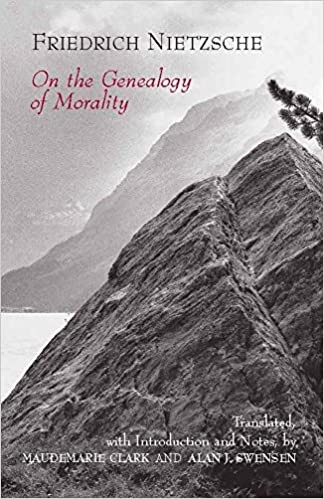In looking for ideas about how to present the history and connectivity of ideas, I returned to Nietzsche's On the Genealogy of Morality, published in 1887. Sharing a few notes with that interest in reading (and only a periphery interest in the arguments of the book).
In the Introduction of the version I read (by Clark and Swensen), Clark offers the following on the historical method of the book: "The purpose served by a thing does not explain its origin; rather, the cause of its coming into being and 'its final usefulness, its actual employment and integration into a system of purposes,' lie worlds apart (GM II:12). Nietzsche's prime example of a violation of this principle is the assumption that the eye was made to see, the hand to grasp. This suggests that his principle of historical method is inspired by Darwin's theory of evolution, according to which the eye's usefulness does not explain why it originally came into existence, but only why, having somehow or other come into existence, it had a greater chance of surviving and being passed on to heirs. To explain how the eye came into existence would be to trace it back through a whole series of previous forms, and transformations of these forms by means of new variations, to something that lies 'worlds apart' from it, say a simple nerve that is particularly sensitive to light. Neitzsche's Genealogy applies the same principle to human history. Questions of origin and purpose are to be separated; the purpose served by a practice or custom does not explain how it came into existence." (p. xxiv)
From Neitzsche (lengthy, as reference for those interested in how this method was described and used):
"we need a critique of moral values, for once the value of these values must itself be called into question—and for this we need a knowledge of the conditions and circumstances out of which they have grown, under which they have developed and shifted" (p. 5)
"How do the previous genealogists of morality carry on in this case? Naively, as they have always carried on-: they discover some "purpose" or other in punishment, for example revenge or deterrence, then innocently place this purpose at the beginning as causa fiendi [cause of the coming into being] of punishment, and - are done. The "purpose in law," however, is the last thing that is usable for the history of the genesis of law: on the contrary, for history of every kind there is no more important proposition than that one which is gained with such effort but also really ought to be gained, namely, that the cause of the genesis of a thing and its final usefulness, its actual employment and integration into a system of purposes, lie toto caelo apart; that something extant, something that has somehow or other come into being, is again and again interpreted according to new views, monopolized in a new way, transformed and rearranged for a new use by a power superior to it; that all happening in the organic world is an over- ' powering, a becoming-lord-over; and that, in turn, all overpowering and becoming-lord-over is a new interpreting, an arranging by means of which the previous "meaning" and "purpose" must of necessity become obscured or entirely extinguished. However well one has grasped the utility of some physiological organ (or of a legal institution, a social custom, a political practice, a for m in the arts or in religious cult), one has still not comprehended anything regarding its genesis: as uncomfortable and unpleasant as this may sound to earlier ears, - for from time immemorial one had thought that in comprehending the demonstrable purpose, the usefulness of a thing, a form, an arrangement, one also comprehended the reason for its coming into being - the eye as made to see, the hand as made to grasp. Thus one also imagined punishment as invented for punishing. But all purposes, all utilities, are only signs that a will to power has become lord over something less powerful and has stamped its own functional meaning onto it; and in this manner the entire history of a "thing," an organ, a practice can be a continuous signchain of ever new interpretations and arrangements, whose causes need not be connected even among themselves - on the contrary, in some cases only accidentally follow and replace one another." (p. 50-51)

